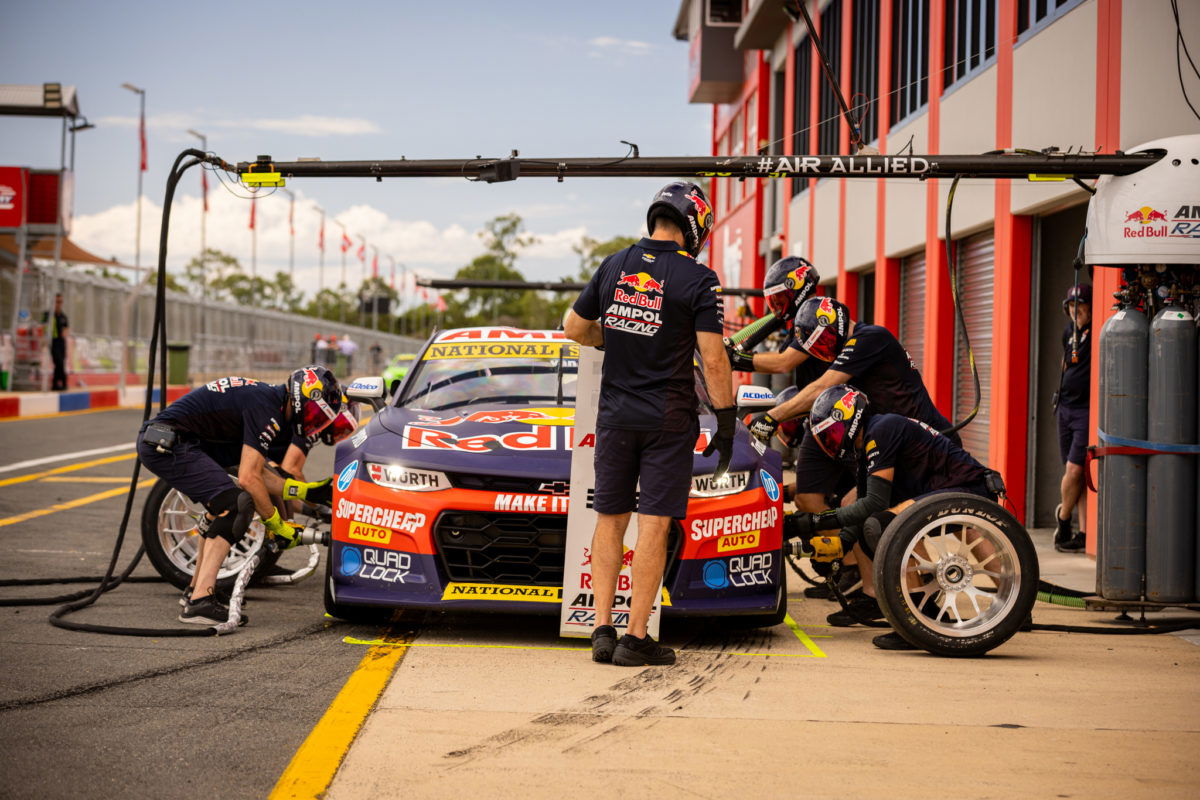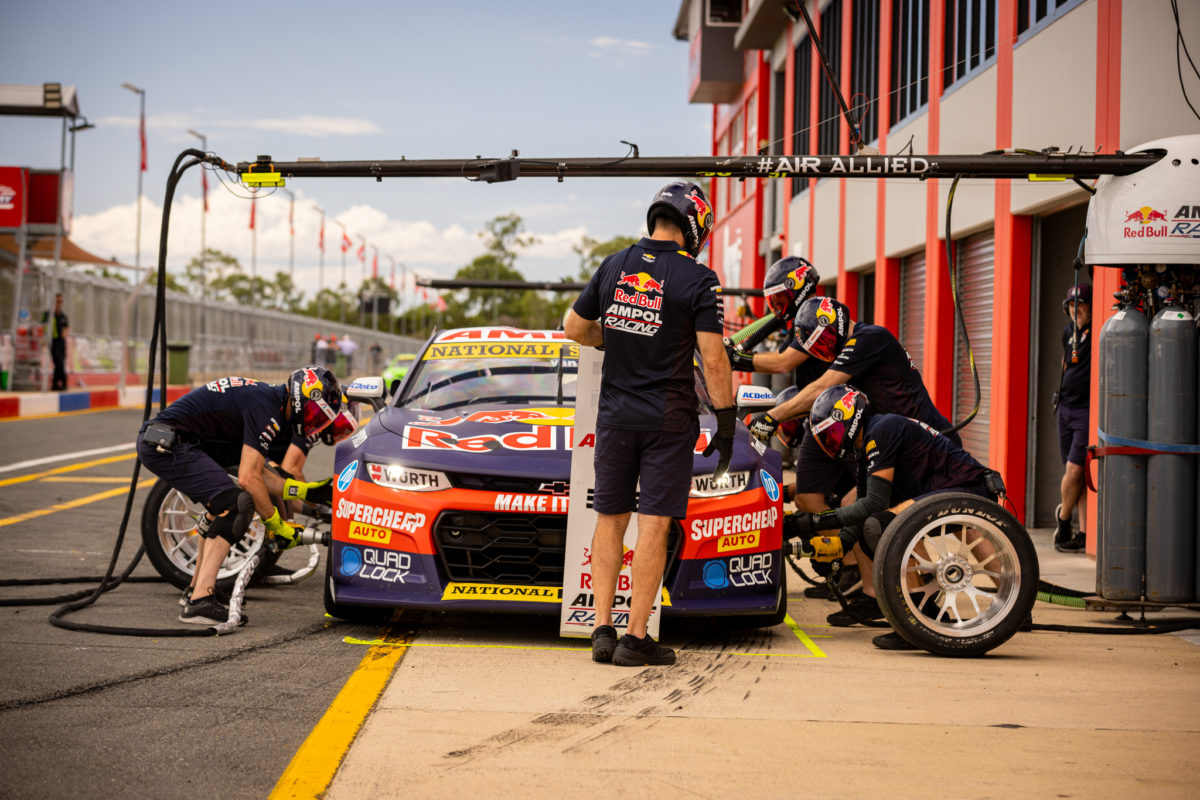

Triple Eight Race Engineering’s Mark Dutton believes there is probably no need for a minimum compulsory pit stops count at the Sandown 500 and Bathurst 1000.
It is now just over a week until practice begins at the Penrite Oil Sandown 500 but no minimum CPS count for the first enduros of the Gen3 era have yet been made official, with the figure to come in the Further Supplementary Regulations.
The matter has, however, been furiously debated within Supercars Commission meetings, Speedcafe understands, with a level of conjecture about how the Chevrolet Camaro and Ford Mustang stack up on fuel economy.
CPSs are hardly new in Supercars but a minimum number of pit stops was introduced to Sandown and Bathurst in 2013, the first year of Car of the Future, as a means of compensating for the disparity in fuel consumption between the incumbent Ford and Chevrolet (Holden) pushrod engines and the new quad cam Mercedes and Nissan units.
A seven-stop mandate for the Bathurst 1000 remained all the way through 2022, the final year of COTF/Gen2, but CPS requirements for that event and the return of the Sandown 500, which was previously a three-stop minimum, were left ‘TBA’ when this year’s Operations Manual was released.
Dutton, Team Manager at Red Bull Ampol Racing and a five-time championship winner as Jamie Whincup’s Race Engineer, thinks it should be left open.
“There’s not a great need at this stage to have too many CPSs, apart from if you want to mandate some brake changes,” he told Speedcafe.
“There is the minimum-maximum driver times and laps, and, apart from that, it should be left up to strategy.
“In the past, the CPSs were only to try to balance out any difference in fuel consumption whereas so far that doesn’t [seem to be the case], from the data seen.
“The proof will really be once we do get to Bathurst to see if one manufacturer is better than the other and have done a good job of hiding it, because it hasn’t been jumping out yet.
“If there’s no reason, then don’t have CPSs, apart from your brake ones; let teams decide what they want to do.
“That used to be the case when you could do it in a four-stopper, but you might take an opportunistic Safety Car and do a five-stopper, or even more depending on when the Safety Cars came out.
“Like, that’s cool if it could be like that.”
The Sandown 500 is, for now, completely laissez-faire except with respect to the maximum continuous driver time of three-and-a-half hours and minimum driver distance of 54 laps which is prescribed via the Operations Manual, although it is worth noting that two sets of brake pads per car are now allowed for the event rather than just one.
It could in fact be feasible to complete the Sandown 500 in just two pit stops, with Speedcafe hearing loose predictions that a co-driver could clear their 54 laps in a single stint.
Whether that would work strategically remains to be seen, even before one reacts to how Safety Cars might fall on the day.
Regardless of how the Mustang’s 5.4-litre quad cam engine compared to the 5.7-litre pushrod in the Camaro, strategy for the Bathurst 1000 is highly likely to change.
The Gen2 cars could only stretch to 23 laps at Mount Panorama, but the Gen3 cars have a 20 percent larger fuel cell, less downforce, and less weight.
They can thus be reasonably expected to clear 27 laps around the 6.213km circuit on fuel and hence a co-driver can complete their minimum 54 laps within two stints, rather than three.
That point made, the life of the soft compound of tyre which is being used at Bathurst for the first time must also be accounted for, and new drop gear ratios for both enduro venues could also conceivably have an effect on fuel economy
As Dutton alluded to, Triple Eight won the 2008 Bathurst 1000 with five pit stops, while the Walkinshaw Holden Racing Team took out that year’s Sandown 500 on a three-stopper.
In 2012, Triple Eight won the Bathurst 1000 with a six-stopper and the Sandown 500 with a three-stopper.
Those seasons are noteworthy because 2008 was the last for E10 fuel, before the introduction of E85 saw consumption jump by about 30 percent, while 2012 was the last of Project Blueprint and 120-litre fuel cells, with the COTF vehicles carrying 111-litre cells.
Nowadays, the field is powered by E75 and a full fuel load is 133 litres.
Practice at Sandown starts on Friday week (September 15).
UPDATE: CONFIRMED: No compulsory pit stops for Sandown 500, Bathurst 1000



















Discussion about this post